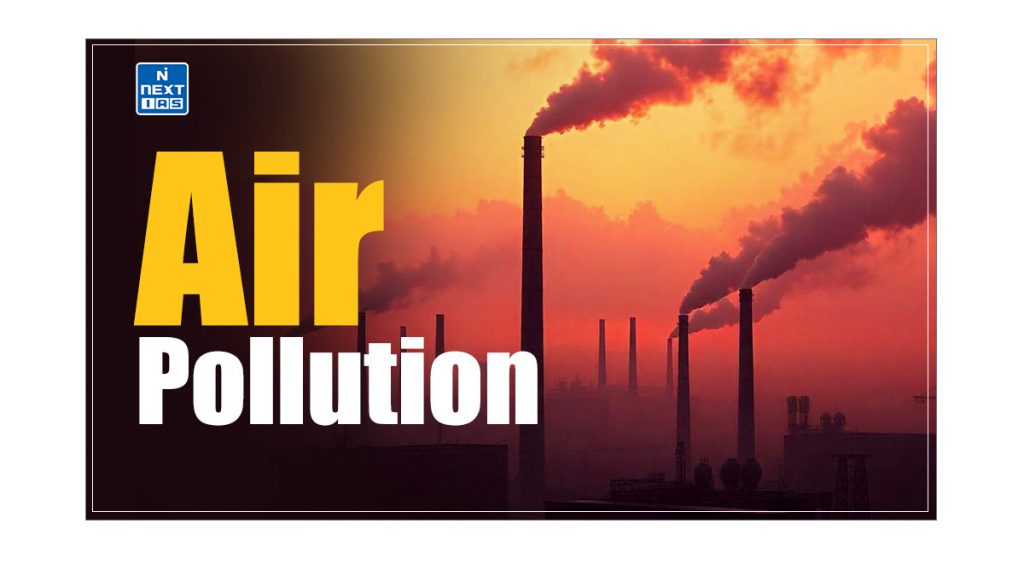
Air Pollution, a pressing environmental and public health issue, has become a significant concern worldwide. Characterised by harmful substances in the air, air pollution adversely affects the environment and human health. This article aims to study air pollution in detail, including its meaning, types, causes, consequences, and related concepts.
What is Air Pollution?
- Air Pollution is the contamination of the atmosphere with harmful substances that can adversely affect human health, ecosystems, and climate.
- The contaminating substances that cause air pollution are called Air Pollutants.
- These substances can be gases, particles, or a combination of both and come from various sources.
- Air Pollution is one of the prominent types of Environmental Pollution.
| What is Environmental Pollution? – Environmental Pollution refers to the introduction of harmful materials into the environment. – In other words, it is the contamination of the physical and biological components of the environment to such an extent that normal environmental processes are adversely affected. – Environmental pollution can be categorised into several types based on the nature of the pollutants and the media they affect, including Air Pollution, Soil Pollution, Water Pollution, etc. Read our detailed articles on: 1. Environmental Pollution 2. Soil Pollution 3. Water Pollution 4. Noise Pollution 5. Thermal Pollution 6. Nuclear Pollution 7. Marine Pollution 8. Plastic Pollution |
Air Pollution in India
- Air pollution is a pressing environmental and public health issue in India, stemming from a combination of industrial emissions, vehicular exhaust, burning of biomass, and construction activities.
- Rapid urbanisation and reliance on fossil fuels have significantly deteriorated air quality, with cities like Delhi and Kanpur frequently recording hazardous pollution levels.
- Seasonal practices like stubble burning in agricultural regions exacerbate the problem, especially in winter.
- This pollution contributes to severe health issues such as respiratory diseases, cardiovascular problems, and reduced life expectancy.
- Despite policy measures like the National Clean Air Programme (NCAP), achieving sustainable solutions requires stricter enforcement, cleaner energy adoption, and increased public awareness.
Read our detailed article on Air Pollution in India.
Types of Air Pollutants

The air pollutants can be classified into the following two types:
Primary Pollutants
- These pollutants enter the air due to a natural event or human activity.
- They can have effects both directly and as precursors of secondary air pollution.
- There are five primary pollutants that contribute about 90 per cent of the global air pollution.
- These are carbon oxides (CO and CO2), nitrogen oxides, sulphur oxides, volatile organic compounds (mostly hydrocarbons), and suspended particulate matter.
Secondary Pollutants
- A secondary pollutant is formed by reacting one primary pollutant with another in the atmosphere.
- For example, Ground-Level Ozone, Smog, acid Rain, sulphuric acid, nitric acid, and carbonic acid.
Sources of Air Pollution
The significant causes of air pollution can be seen as follows:
- Industrial Emissions: The burning of fossil fuels for energy production, manufacturing processes, and transportation releases air pollution, such as particulate matter, sulfur oxides, nitrogen oxides, and greenhouse gases, into the air.
- Vehicle Emissions: Exhaust from cars, trucks, motorcycles, and other vehicles contribute to air pollution, particularly in urban areas.
- Domestic Combustion: The burning of wood, coal, and other fuels for cooking and heating in homes releases air pollutants, causing air pollution.
- Agricultural Activities: Using chemical fertilisers and pesticides and burning agricultural waste can release harmful substances into the atmosphere.
- Natural Sources: Volcanic eruptions, forest fires, and dust storms pollute the air pollution.
Impacts of Air Pollution
The impacts of the air pollution can be seen as follows:
- Health Impacts
- Air pollution poses serious health risks, including respiratory diseases such as asthma and chronic bronchitis, cardiovascular conditions, and premature mortality.
- Exposure to high levels of air pollution can also exacerbate health problems and reduce life expectancy.
- Long-term exposure to air pollution can also adversely affect cognitive development, especially in children.
- Environmental Impact
- Air pollution adversely affects ecosystems by contaminating soil and water bodies, damaging vegetation, and impacting wildlife.
- High concentrations of sulfur dioxide and nitrogen oxides can lead to Acid Rain, which has its environmental impacts.
- Some air pollutants, such as greenhouse gases (e.g., carbon dioxide and methane), contribute to global warming and climate change by trapping heat in the Earth’s atmosphere.
- Economic Impacts
- Air pollution can have significant economic costs, including increased healthcare expenditures, reduced productivity, and property damage.
- Air pollution reduces agricultural productivity by damaging the soil.
- Acid rain can damage forests, lakes, and buildings.
Suggested Measures to Control Air Pollution
The suggested measures to control air pollution are:
Preventive Measures
- Cleaner fuels, such as Liquefied Natural Gas (LNG), are cheaper and more environmentally friendly for power plants.
- Hydrogen fuel and e-vehicles should be promoted to control air pollution.
- Environment-friendly industrial processes should be encouraged to minimise the emission of pollutants and hazardous wastes.
- Increasing the height of chimneys, closing hazardous industries, shifting polluting industries away from cities, and developing and maintaining green belts of adequate width can significantly reduce air pollution.
- Setting up emission standards for automobiles has already improved vehicular emissions. Further research and technological innovation will greatly reduce air pollution.
- In bigger cities like Delhi and Mumbai, motor vehicles need to obtain Pollution Under Control (PUC) Certificate at regular intervals. This ensures that levels of pollutants emitted from vehicle exhaust are always within the prescribed legal limits.
- Alternate fuels like CNG are being encouraged for use in public transport vehicles.
Effluent Control
Air Pollution can be minimised by installing devices that reduce the release of pollutants. Some devices that can help minimise the air pollution as they restrict the release of air pollutants in the atmosphere are as follows:
Filters
- Filters remove particulate matter from the gas stream.
- The medium of a filter may be made of fibrous materials like cloth, granular materials like sand, rigid materials like a screen, or mats like felt pads.
Electrostatic Precipitators (ESP)
- The flue gas dust is charged with ions, and the ionised particulate matter is collected on an oppositely charged plate.
- The particles are removed from the collecting plate by occasional shaking or by rapping the surface.
- ESPs are used in boilers, furnaces, thermal power plants, cement factories, steel plants, etc.
Scrubber
- It is a system that removes harmful materials from industrial exhaust gases before they are released into the environment.
- Scrubbers help prevent the formation of acid rain by removing acidic gases from the exhaust before they are released into the sky.
- These are mainly of 2 types:
- Wet Scrubbing: The removal of harmful components of exhausted flue gases by spraying a liquid substance through the gas.
- Dry Scrubbing: The removal of harmful components of exhausted flue gases by introducing a solid substance to the gas – generally in powdered form.
Other Measures
In addition to all the measures mentioned above, the following measures can be taken to control air pollution:
- Instead of burning waste outdoors, composting waste is advisable. The compost can be used on the farm.
- The use of air conditioners should be minimised.
- Planting of trees must be encouraged. Trees absorb carbon dioxide from the atmosphere and filter the pollution.
- Regular maintenance of vehicles should be ensured for better engine efficiency and reduced pollution levels.
- Walking and bicycling for work in the vicinity should be adopted.
- The use of public transport should be imbibed at an individual level. Moreover, we should encourage family members to use public conveyance as much as possible. It can save us money and reduce air pollution.
Conclusion
Air pollution remains a critical issue with far-reaching effects on human health, the environment, and climate. Addressing this challenge requires a multifaceted approach, including legislative measures, technological innovations, public awareness, and international cooperation. Implementing effective strategies and fostering collective efforts can mitigate air pollution and ensure a healthier and more sustainable future for all.
Major Air Pollutants: Sources and Impacts
Some of the major air pollutants, their sources, and effects are given in the table below.
Air Pollutants Included in NAAQS
The air pollutants included in NAAQS are as follows:
| Pollutant | Description | Source(s) | Impacts |
|---|---|---|---|
| Carbon Monoxide (CO) | • An odourless, colourless, tasteless and poisonous gas. • Produced by the incomplete burning of fossil fuels like gasoline, oil, and natural gas. • Slightly lighter than air. | • Exhaust of Internal Combustion Engines, especially of vehicles with petrol engines. • Forest fires, Wood stoves, cigarette smoke, and burning of crop residues. | • CO interferes with the blood’s ability to carry oxygen, slowing reflexes and causing drowsiness. In high concentrations, CO can cause death. • Heart patients are sensitive to CO and may experience chest pain. • Adverse effect on the foetus of a pregnant woman. |
| Sulphur Dioxide (SO2) | • Produced by volcanoes and in various industrial processes. | • Combustion of fossil fuels. • Paper Industry. • Petroleum Refining. • Smelting of metals. | • Respiratory illness, visibility impairment, aggravates existing heart and lung disease. • Acid Rain • Aesthetic damage to properties. |
| Nitrogen Oxides (NOx) | • Nitrogen and oxygen combine during combustion to form nitrogen oxides. • Many nitrogen oxides are colourless and odorless gases. | • Burning of biomass and fossil fuels. • High-temperature combustion (IC Engines, fossil fuel-fired power stations, industries). | • Irritates nose, throat and lungs. • Aggravate asthma or chronic bronchitis. Increases vulnerability to respiratory infections such as influenza or common colds. • Smog formation, Acid rain. • NOx easily dissolves in water and forms acids, which can cause metal corrosion and deterioration in fabric quality. |
| Lead | • Bright, silvery, soft, dense, ductile, highly malleable, bluish-white metal. • Poor electrical conductivity. • High corrosion resistance. | • Waste incineration. • Metal Processing. • Paint Industry. • Automobile exhaust. • Food (as plants absorb lead). | • Adverse effects on the central nervous system, cardiovascular system, kidneys and immune system. • Causes blood disorders like anaemia and increase in blood pressure. • Reduces the cognitive capacity of children. • Miscarriage, delay in puberty. • Reduction of fertility in males. |
| Volatile Organic Compounds (VOCs) | • VOCs are organic compounds that vaporise easily. • Gasoline, benzene, toluene and xylene are examples. • Emitted as fumes. | • Solvents, cleaning supplies, paints, and glues. • Automobile exhaust. | • May cause chromosomal damage. • Affect the reproductive system, developing foetus and fertility in men. • May cause Cancer. • Contribute to smog formation. |
| Ozone (O3) | • A pale blue gas • Soluble in water and non-polar solvents. • Ozone is created by a chemical reaction between NOx and VOCs in sunlight. | • Formed by the reaction of sunlight with air, containing hydrocarbons and nitrogen oxides emitted by car engines and industrial operations. • Electronic equipment such as photocopiers. | • Lung Function deficits. • Respiratory illness. • Premature death, asthma, bronchitis, heart attack and other cardiopulmonary problems. • Stunts the overall growth of some plants. It damages the leaves of trees and other plants. • Decreases the ability of plants to produce and store food and reduces crop yield. |
| Particulate Matter(PM 2.5 and PM 10) | • Solid or liquid matter that is suspended in the air. • To remain in the air, particles usually must be less than 0.1 mm wide and can be as small as 0.00005 mm. | • Road traffic emissions. • Industrial Combustion plants for power generation. • Construction activities. • Residential combustion. • Wind-blown dust such as road dust, fly ash, and soot. | • Visibility reduction. • Cardiopulmonary problems. • Asthma, chronic bronchitis and pneumonia in elderly people. • Aesthetic damage to properties. |
Air Pollutants Not Included in NAAQS
The air pollutants which are not included in NAAQS are as follows:
| Pollutant | Description | Source(s) | Impacts |
|---|---|---|---|
| Carbon Dioxide (CO2) | • Colorless gas. | • Respiration by animals and plants. • Burning of Fossil fuels. | • Green House effect and climate change • Breathlessness, Headache, Chest congestion. |
| Chloro-fluoro-carbons (CFC) | • Non-toxic, non-flammable. | • Air conditioners, refrigerators. • Foam insulations • Aerosol propellants • Solvent cleaners. | • Depletion of stratospheric Ozone. It protects humans from harmful UV radiation. • Enhanced UV rays cause skin cancer, cataracts, etc. |
| Noise | • Factories, Industries, Transportation. • Religious and cultural activities. | • Auditory problems. • Speech interference. • Annoyance. • Loss in Efficiency. • Physiological disorders. |
Indoor Air Pollution
- Over 3 billion people use solid fuels like wood, charcoal, cow dung and crop waste to cook food on traditional stoves or open fires.
- Such inefficient practices produce high levels of indoor air pollution by releasing a range of health-damaging pollutants such as fine particles and carbon monoxide.
- Smoke in and around poorly ventilated dwellings can exceed threshold pollution levels and may lead to health hazards.
- Women and young children, having high exposure to such pollution, suffer from acute respiratory problems, which include cough, lung infection, asthma, noisy respiration and wheezing.
- Indoor air problems can be subtle and are not always recognisable.
- According to the World Health Organization (WHO), 4.3 million people die from exposure to household indoor air pollution each year.
Smog
- It is a type of air pollution derived from vehicular emissions and industrial fumes that react in the atmosphere with sunlight to form secondary pollutants.
- These secondary pollutants combine with the primary emissions to form photochemical smog.
- One of the primary components of photochemical smog is Ozone.
- Ozone in the stratosphere protects the Blue Planet, but ozone is a harmful pollutant in the troposphere that is detrimental to human and environmental health.
Fly Ash
- The ash produced mostly by thermal power plants as by-products of coal burning operations is termed Fly ash.
- It consists primarily of oxides of silicon, aluminium, iron and calcium.
- Magnesium, potassium, sodium, titanium, and sulfur are also present to a lesser degree.
- Fly ash pollutes the air as well as water.
- It affects vegetation through direct deposition on leaf surfaces or indirectly through its deposition on soil.
- Fly ash is used to make bricks and as a landfill material.
- Bricks of fly ash have increased strength and durability, making them more resilient.
- It is also less susceptible to chemical attacks.
- Recognising the value of fly ash, the Ministry of Environment and Forests has made it mandatory to use Fly ash in all construction projects, road embankment works, and landfilling works within a 100 km radius of coal or lignite-based thermal power plants.






